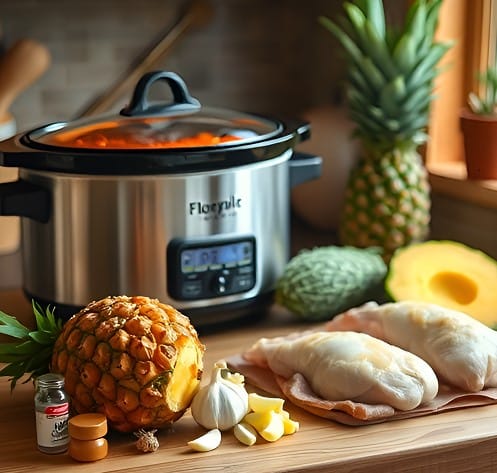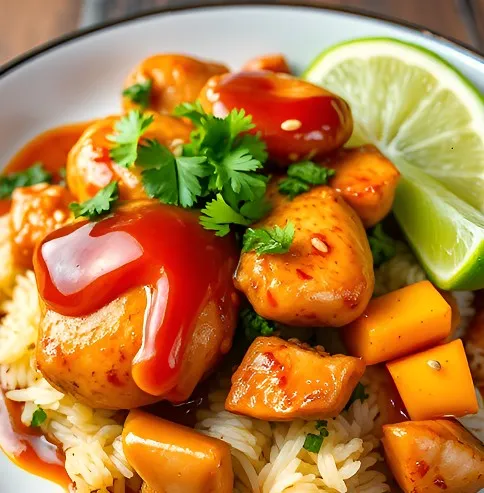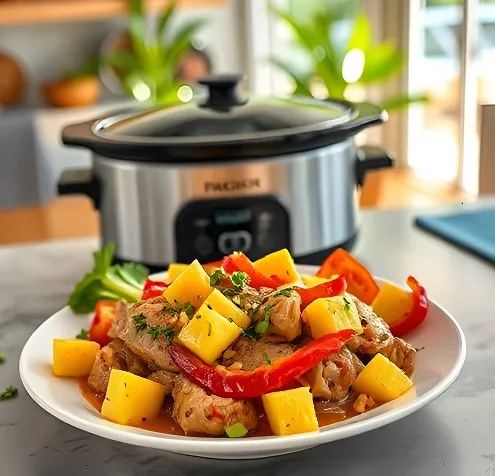Imagine a Crockpot Hawaiian Chicken that perfectly marries the savory depth of a well-seasoned protein with the sweet, tangy burst of tropical fruit—a meal that whisks you away to a sun-soaked island with every bite. This Crockpot Hawaiian Chicken does exactly that, offering convenience and versatility without sacrificing flavor. Whether you’re scrambling to put together dinner on a hectic weeknight, planning a potluck to dazzle friends, or even laying the groundwork for next week’s meal prep, this Crockpot Hawaiian Chicken recipe has you covered. The ease of preparation paired with the striking balance of flavors makes it a standout favorite.
Table of Contents
Set the Stage for Your Tropical Creation
Before you dive into the cooking process, assembling the right ingredients and tools is crucial to achieving that perfect balance between savory and sweet. The heart of this dish is high-quality chicken, so select boneless, skinless chicken breasts or opt for thighs if you prefer a richer, more succulent texture. Thighs offer natural fat that can boost flavor, while breasts provide a leaner alternative—choose what best suits your taste and nutritional goals.
Next up is pineapple, the star that infuses the dish with an unmistakably tropical vibe. You can use fresh pineapple cut into bite-sized chunks, or opt for canned pineapple chunks for convenience—but be sure to reserve a bit of the juice for an extra burst of flavor. Complement your pineapple with soy sauce, a pantry staple that deepens the savory profile. Brown sugar plays a critical role, lending a nuanced sweetness that counterbalances the tangy fruit, while a touch of ketchup adds body and a slight tang to the sauce.
No Hawaiian meal would be complete without aromatic spices. Garlic and ginger—whether freshly minced or lightly powdered—create a fragrant foundation that elevates the overall experience. For those who enjoy an extra layer of flavor and color, consider incorporating bell peppers and onions. A pinch of red pepper flakes can also be introduced if you’re seeking a subtle kick, adding complexity without overwhelming the tropical theme.
Equally important is using the proper equipment to ensure smooth preparation. A 6‑quart slow cooker is ideal to provide even heat and ample space; make sure you have precision with your measuring cups and spoons. Lastly, a sharp cutting board and knife make the preliminary work efficient and safe. Together, these ingredients and tools lay a solid groundwork for a Crockpot Hawaiian Chicken that’s as visually appealing as it is delectable.

Step-by-Step Cooking Instructions: From Prep to Plate
Transforming your kitchen into a vibrant tropical haven starts with some thoughtful preparation. Begin by handling the chicken with care: rinse each piece under cool water and pat thoroughly dry using paper towels. If you’re using breasts, trim away any excess fat or tendons to ensure every bite is tender and clean. This small step goes a long way in elevating the dish’s overall texture.
For the pineapple, if you’re opting for the canned variety, drain the juice—but don’t toss it all away. Save about ¼ cup as it will seamlessly blend into your sauce and help maintain moisture. When using fresh pineapple, remove the skin and eyes carefully, then cut the fruit into uniform chunks so that every spoonful delivers a burst of flavor.
Next comes the sauce—the soul of our Crockpot Hawaiian Chicken creation. In a mixing bowl, combine ½ cup of soy sauce with ⅓ cup of brown sugar. Pour in the reserved pineapple juice alongside an extra ¼ cup if needed for vibrancy. Add 1 tablespoon of ketchup for a touch of tang and 1 teaspoon each of minced garlic and ginger to spark the aroma. Stir the blend until the sugar and spices are well dissolved; this ensures a harmonious fusion of flavors.
If you’re keen to add extra dimensions to your Crockpot Hawaiian Chicken, slice bell peppers and onions into strips or bite-sized chunks and have them ready. Their vibrant colors and textures will not only enhance the presentation but also add a subtle crunch to the meal.
Safety Spotlight: is it Perfectly Safe to Use Raw Chicken in a Slow Cooker
One common question that often arises is whether it is safe to place raw chicken directly into a slow cooker. The answer is a confident yes—provided you adhere to a few simple safety measures. Slow cookers are engineered to bring food to a safe temperature slowly and steadily. This gradual warmth ensures that the chicken’s internal temperature rises sufficiently to eliminate harmful bacteria like salmonella and E. coli. The key is reaching an internal temperature of 165°F (74°C), which the USDA determines as safe for poultry.
Slow cookers operate by circulating low, consistent heat from the base and sides, while the lid traps steam. This creates an environment where moisture is retained and heat is evenly distributed, making it an excellent method for cooking raw meats. When you start with cold ingredients, the slow cooker takes its time to warm up—this slow heating process gives bacteria no safe haven, as the entire cavity of the device gradually reaches temperatures that are inhospitable to pathogens.
There are a few tips to keep in mind, however. Always arrange raw chicken in a single layer to allow heat to penetrate uniformly. Avoid lifting the lid unnecessarily, as every peek lets out precious heat and lengthens the cooking time. Using a meat thermometer is the most reliable way to ensure that your chicken is cooked through. By observing these guidelines, you not only maintain peak flavor and texture but also ensure food safety without any added worry.
What to Serve with Your Crockpot Hawaiian Chicken
While this Crockpot Hawaiian Chicken stands out as a vibrant and complete dish on its own, pairing it with the right side dishes can elevate your dining experience even further. The sauce-rich nature of the chicken calls for sides that can absorb its flavors, creating a harmonious and balanced meal. For instance, a bowl of fluffy steamed white or jasmine rice serves as the perfect canvas for the tangy, sweet sauce. The neutral taste of rice complements the bold flavors of the Crockpot Hawaiian Chicken, ensuring that every forkful bursts with balanced taste.
If you’re in the mood for a just-as-comforting twist, creamy mashed potatoes make a delightful companion. Their soft texture pairs beautifully with the tender chicken, while the slight buttery flavor enhances the overall tropical feel. For a lighter option, consider a quick vegetable stir-fry. A medley of broccoli, carrots, and snap peas sautéed with garlic adds not only a bright splash of color but also a satisfying crunch that contrasts with the silky sauce.
For those who want to continue the island theme, Hawaiian rolls—soft and slightly sweet—allow you to scoop up every last drop of the sumptuous sauce. Alternatively, coconut rice, infused with a splash of creamy coconut milk, amplifies that tropical vibe without overwhelming the palate. An innovative option is pineapple salsa: a refreshing combination of diced pineapple, red onion, cilantro, and a drizzle of lime juice creates a zesty topper for the chicken.

Avoiding Rubbery Chicken Every Time
Even with a foolproof Crockpot Hawaiian Chicken recipe, sometimes the unexpected happens and chicken can turn out rubbery instead of tender and juicy. There are several culprits behind this texture dilemma. One of the most common reasons is overcooking. It might seem odd in a slow cooker, but if chicken—especially lean breasts—is left for too long, even low heat can lead to dryness and a rubbery consistency. Additionally, using the wrong cut of chicken can play a part; while lean chicken breasts cook quickly, they lack the fat that helps retain moisture, unlike thighs which provide a natural bastion against toughness.
Another factor to consider is cooking temperature. Running the slow cooker on a high setting can lead to faster evaporation of the cooking liquid, leaving your chicken drier than desired. Insufficient moisture is also to blame sometimes. When the sauce isn’t abundant enough to envelop the meat, the chicken can dry out and develop a less-than-desirable texture.
To prevent rubbery chicken, start by selecting chicken cuts that inherently carry more fat, such as thighs. Stick to low heat settings and monitor cooking times closely; investing in a reliable meat thermometer ensures the chicken reaches the perfect internal temperature of 165°F (74°C) without overdoing it. Maintaining an adequate amount of sauce during the entire cooking process is equally important—don’t be afraid to add a splash more liquid if your slow cooker tends to evaporate moisture quickly. With these troubleshooting tips in mind, you’ll ensure every batch of Crockpot Hawaiian Chicken is succulent and satisfying.
High vs. Low Settings
There’s often a debate in the kitchen about whether to cook chicken on high or low heat in a slow cooker. Both settings have their merits, but when it comes to achieving that tender, flavor-packed result in your Crockpot Hawaiian Chicken, the temperature setting makes all the difference. Cooking on low heat, typically for 6-8 hours, lets the chicken slowly absorb the aromatic sauce, gradually breaking down fibers and ensuring a moist, melt-in-your-mouth texture. The leisurely pace allows every spice and ingredient to infuse deeply into the meat, creating a harmonious blend of flavors that’s hard to beat.
On the other hand, using the high heat setting gets the meal on your table faster, usually in 3-4 hours. While this is a welcome option when time is of the essence, high heat can sometimes lead to a less consistent result. The rapid cooking process increases the risk of drying out lean cuts, and you’ll need to be extra vigilant about checking doneness to avoid overcooking.
For the slow cooker purists and those who cherish perfectly tender chicken, the low setting is typically the best choice for this Crockpot Hawaiian Chicken recipe. Not only does it help the meat retain its delicate juices, but it also encourages a deeper meld of flavors in the sauce. Regardless of the setting you choose, using a meat thermometer remains a non-negotiable step in ensuring that the internal temperature hits at least 165°F (74°C) for food safety. Adjusting the amount of liquid can also help compensate for evaporation—especially when cooking on high heat. Ultimately, balancing the convenience of time with the technique of slow cooking will guide you toward consistently perfect results.
Liquid Logic in a Slow Cooker: To Cover or Not to Cover?
One of the questions that often puzzles home cooks is whether chicken needs to be entirely submerged in liquid when using a slow cooker. In the case of our Crockpot Hawaiian Chicken, the answer is a nuanced “no.” Slow cookers are ingenious appliances that create a sealed environment where steam is recycled continuously, allowing the chicken to slowly release its natural juices. These juices combine with the sauce ingredients to form a rich, flavorful broth that infuses the chicken without necessarily drowning it.
A minimal amount of liquid is key. The Crockpot Hawaiian Chicken calls for a savory-sweet blend that lightly coats the bottom and permeates the meat as it cooks. This approach retains a concentrated flavor profile while ensuring the chicken stays moist throughout the process. In dishes like hearty stews or soups, ample liquid is essential to create a broth—but for your tropical chicken, too much liquid can dilute the impact of those vibrant flavors

